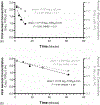The influence of temperature, humidity, and simulated sunlight on the infectivity of SARS-CoV-2 in aerosols
- PMID: 38077296
- PMCID: PMC10698725
- DOI: 10.1080/02786826.2020.1829536
The influence of temperature, humidity, and simulated sunlight on the infectivity of SARS-CoV-2 in aerosols
Abstract
Recent evidence suggests that respiratory aerosols may play a role in the spread of SARS-CoV-2 during the ongoing COVID-19 pandemic. Our laboratory has previously demonstrated that simulated sunlight inactivated SARS-CoV-2 in aerosols and on surfaces. In the present study, we extend these findings to include the persistence of SARS-CoV-2 in aerosols across a range of temperature, humidity, and simulated sunlight levels using an environmentally controlled rotating drum aerosol chamber. The results demonstrate that temperature, simulated sunlight, and humidity are all significant factors influencing the persistence of infectious SARS-CoV-2 in aerosols, but that simulated sunlight and temperature have a greater influence on decay than humidity across the range of conditions tested. The time needed for a 90% decrease in infectious virus ranged from 4.8 min at 40 °C, 20% relative humidity, and high intensity simulated sunlight representative of noon on a clear day on the summer solstice at 4°N latitude, to greater than two hours under conditions representative of those expected indoors or at night. These results suggest that the persistence of infectious SARS-CoV-2 in naturally occurring aerosols may be affected by environmental conditions, and that aerosolized virus could remain infectious for extended periods of time under some environmental conditions. The present study provides a comprehensive dataset on the influence of environmental parameters on the survival of SARS-CoV-2 in aerosols that can be utilized, along with data on viral shedding from infected individuals and the inhalational infectious dose, to inform future modeling and risk assessment efforts.
Conflict of interest statement
Disclosure statement The authors have no conflicts of interest to disclose.
Figures






References
-
- Chao C, Wan MP, Morawska L, Johnson GR, Ristovski ZD, Hargreaves M, Mengersen K, Corbett S, Li Y, Xie X, et al. 2009. Characterization of expiration air jets and droplet size distributions immediately at the mouth opening. J. Aerosol Sci 40 (2):122–33. doi:10.1016/j.jaerosci.2008.10.003. - DOI - PMC - PubMed
LinkOut - more resources
Full Text Sources
Miscellaneous
